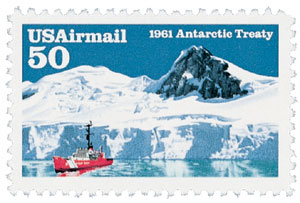
# 2386 FDC - 1988 25c Antarctic Explorers: Nathaniel Palmer, Black Omitted Error
25¢ Nathaniel Palmer
Antarctic Explorers
City: Washington, DC
Quantity: 40,535,625
Printed By: American Bank Note Co
Printing Method: Photogravure
Perforations: 11
Color: Multicolored
First Americans Sight Antarctica
Born in 1799 in Stonington, Connecticut, Palmer had a life-long love of the sea. As a child, he played in his father’s shipyard and began working on his first ship at just 14 years old.

Palmer’s hometown of Stonington was a major sealing port. At that time, sealskins were a popular trade item with China. Palmer quickly established himself as a skilled and daring seal hunter during his frequent travels to South America. By the time Palmer turned 21, he had received his first command – captaining the 47-foot-long sloop Hero.

By 1820, the traditional sealing spots off the coasts of South America and the Falkland Islands were barren, leading explorers to search further south. That November, Palmer joined an expedition to the South Shetland Islands. When they found no seals there, Palmer forged ahead, taking advantage of his small boat that could easily navigate the islands.

On November 17, Palmer sailed south from Deception Island and saw “land not yet laid down on my chart.” Palmer and his men had found Antarctica. Two other explorers had seen the land earlier that year – Edward Bransfield and William Smith of Ireland and England respectively. But Palmer was the first American. The spot he sighted was later named Palmer Land in his honor. The following year, Palmer returned to the area and joined in the discovery of the nearby South Orkney Islands archipelago.

Palmer continued his successful sealing career until he embarked on a new career, sailing express freight around the world. During his decades at sea, Palmer saw first-hand the strengths and weaknesses of the day’s ships. He proposed and designed his own improvements, earning him a credit as co-developer of the clipper ship.

In his later years, Palmer settled in Stonington, where he owned clipper ships that others sailed for him. His legacy in the Antarctic continues today with the Palmer Archipelago, Palmer Station, the clipper ship N.B. Palmer, and the icebreaker Nathaniel B. Palmer. Additionally, Hero Bay in the South Shetland Islands is named after his ship.
25¢ Nathaniel Palmer
Antarctic Explorers
City: Washington, DC
Quantity: 40,535,625
Printed By: American Bank Note Co
Printing Method: Photogravure
Perforations: 11
Color: Multicolored
First Americans Sight Antarctica
Born in 1799 in Stonington, Connecticut, Palmer had a life-long love of the sea. As a child, he played in his father’s shipyard and began working on his first ship at just 14 years old.

Palmer’s hometown of Stonington was a major sealing port. At that time, sealskins were a popular trade item with China. Palmer quickly established himself as a skilled and daring seal hunter during his frequent travels to South America. By the time Palmer turned 21, he had received his first command – captaining the 47-foot-long sloop Hero.

By 1820, the traditional sealing spots off the coasts of South America and the Falkland Islands were barren, leading explorers to search further south. That November, Palmer joined an expedition to the South Shetland Islands. When they found no seals there, Palmer forged ahead, taking advantage of his small boat that could easily navigate the islands.

On November 17, Palmer sailed south from Deception Island and saw “land not yet laid down on my chart.” Palmer and his men had found Antarctica. Two other explorers had seen the land earlier that year – Edward Bransfield and William Smith of Ireland and England respectively. But Palmer was the first American. The spot he sighted was later named Palmer Land in his honor. The following year, Palmer returned to the area and joined in the discovery of the nearby South Orkney Islands archipelago.

Palmer continued his successful sealing career until he embarked on a new career, sailing express freight around the world. During his decades at sea, Palmer saw first-hand the strengths and weaknesses of the day’s ships. He proposed and designed his own improvements, earning him a credit as co-developer of the clipper ship.

In his later years, Palmer settled in Stonington, where he owned clipper ships that others sailed for him. His legacy in the Antarctic continues today with the Palmer Archipelago, Palmer Station, the clipper ship N.B. Palmer, and the icebreaker Nathaniel B. Palmer. Additionally, Hero Bay in the South Shetland Islands is named after his ship.










